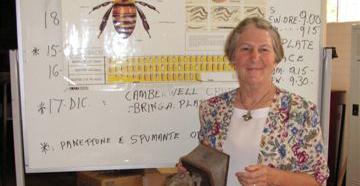
Busy Life of Bees
You are here

Our guest speaker was Bev Jeffrey, who has been a long-standing member of the club. Bev has been keeping bees in Ashburton for 20 years and 2 months! Bee Keepers must be registered with the Department of Primary Industry.
Bev also joined a bee club for fellowship and helpful information. Keepers are allowed a maximum of 2 hives, but Bev has 4; with a couple in her friends’ gardens. Bev did a beekeepers beginners course.
Bev told many fascinating tales about the bees – bees would sting black fluffy things by instinct, as it reminds them of black bears. Green is the best colour for the beekeeper’s veil, and you do need to wear gloves.
Only the worker bees – females – will sting and they die afterwards. The Queen and males (drones) don’t sting.
Bees hibernate in their hives in winter and swarm in spring. The Queens moves out and takes half the hive with her to prevent overcrowding.
Females swarm to seek a new home in protected spots.
Bev collects a swarm in a cardboard box, and then transfers them to the wooden hive, where they start producing honeycomb. She uses wooden frames with wax panels to start the production of comb.
Bev melts the overused wax in a solar melter and moulds the wax into decorative shapes, which have won prizes.
Beeswax is also used to make furniture polish, candles and in lipstick.
To introduce a new Queen into the hive, you need to sprinkle talcum powder over all the bees, to disguise the new Queen’s pheromones; otherwise they would kill her.
The best honey is purchased from local beekeepers, NOT from the supermarket.







